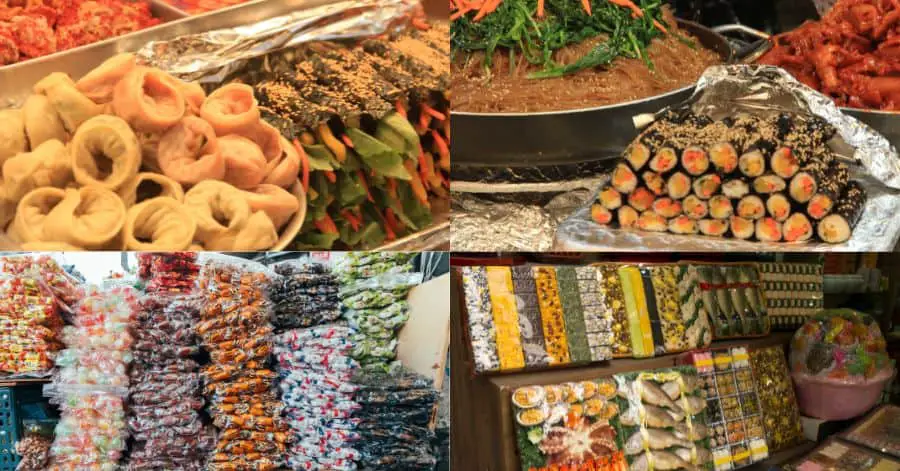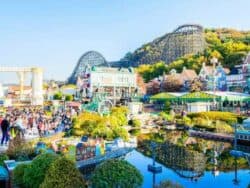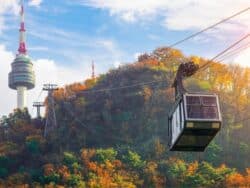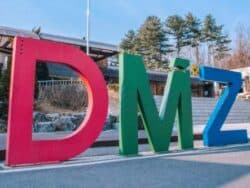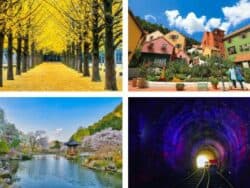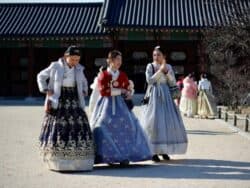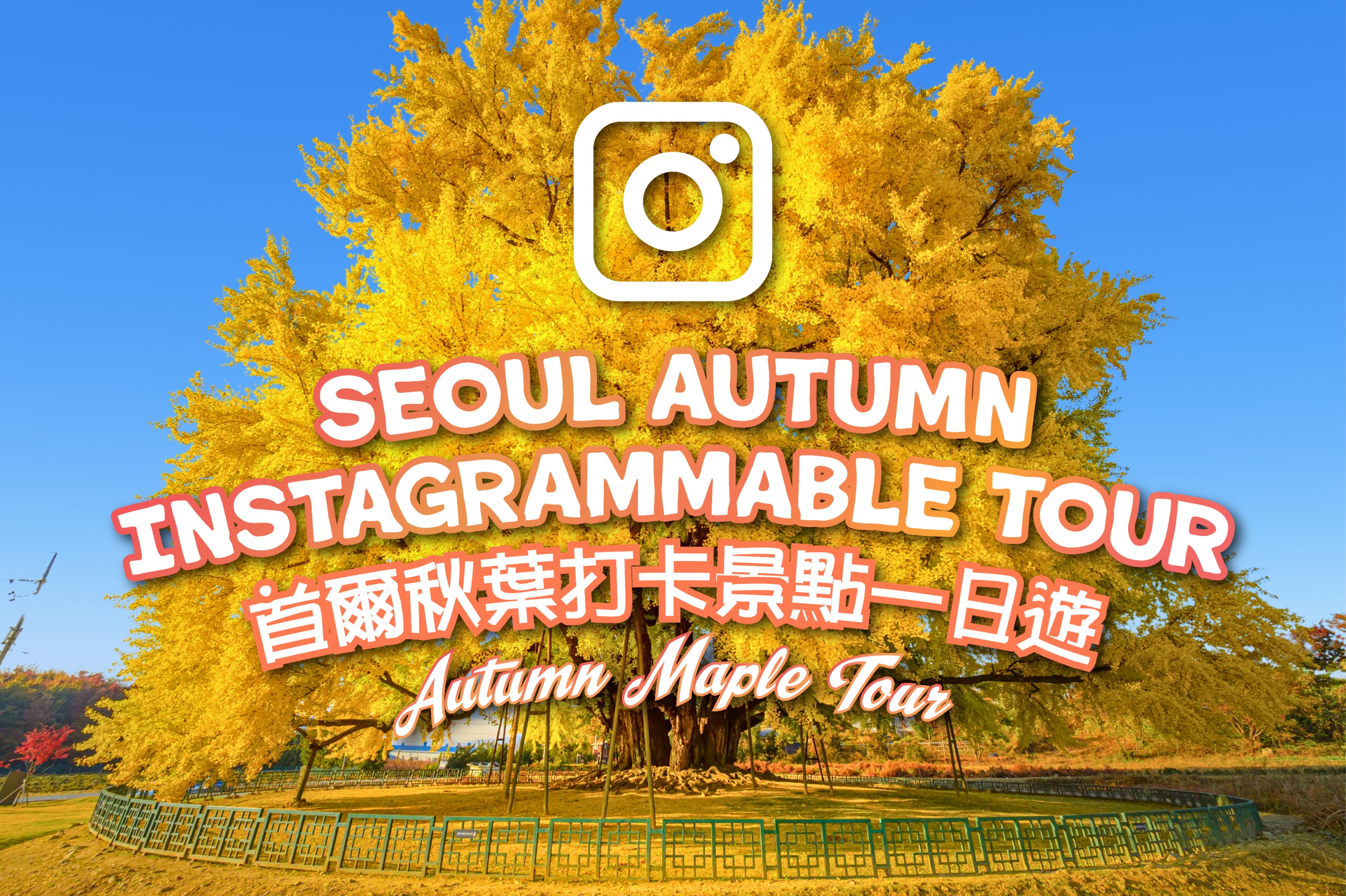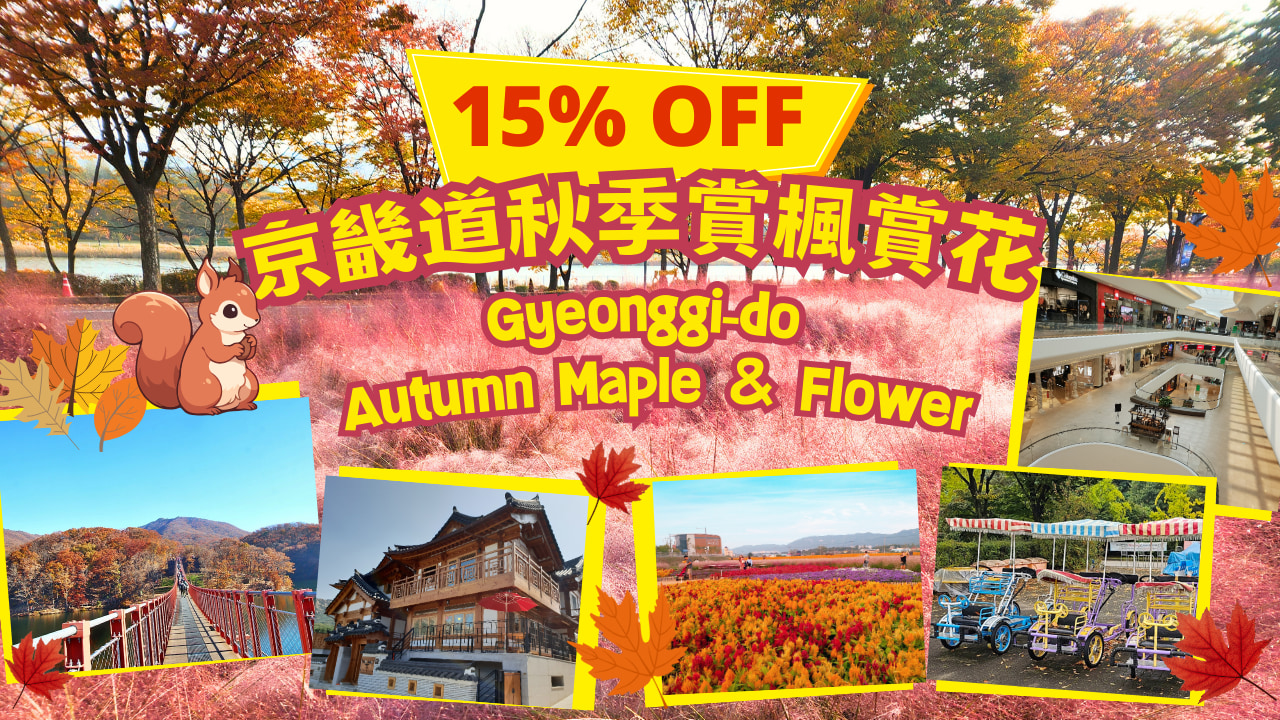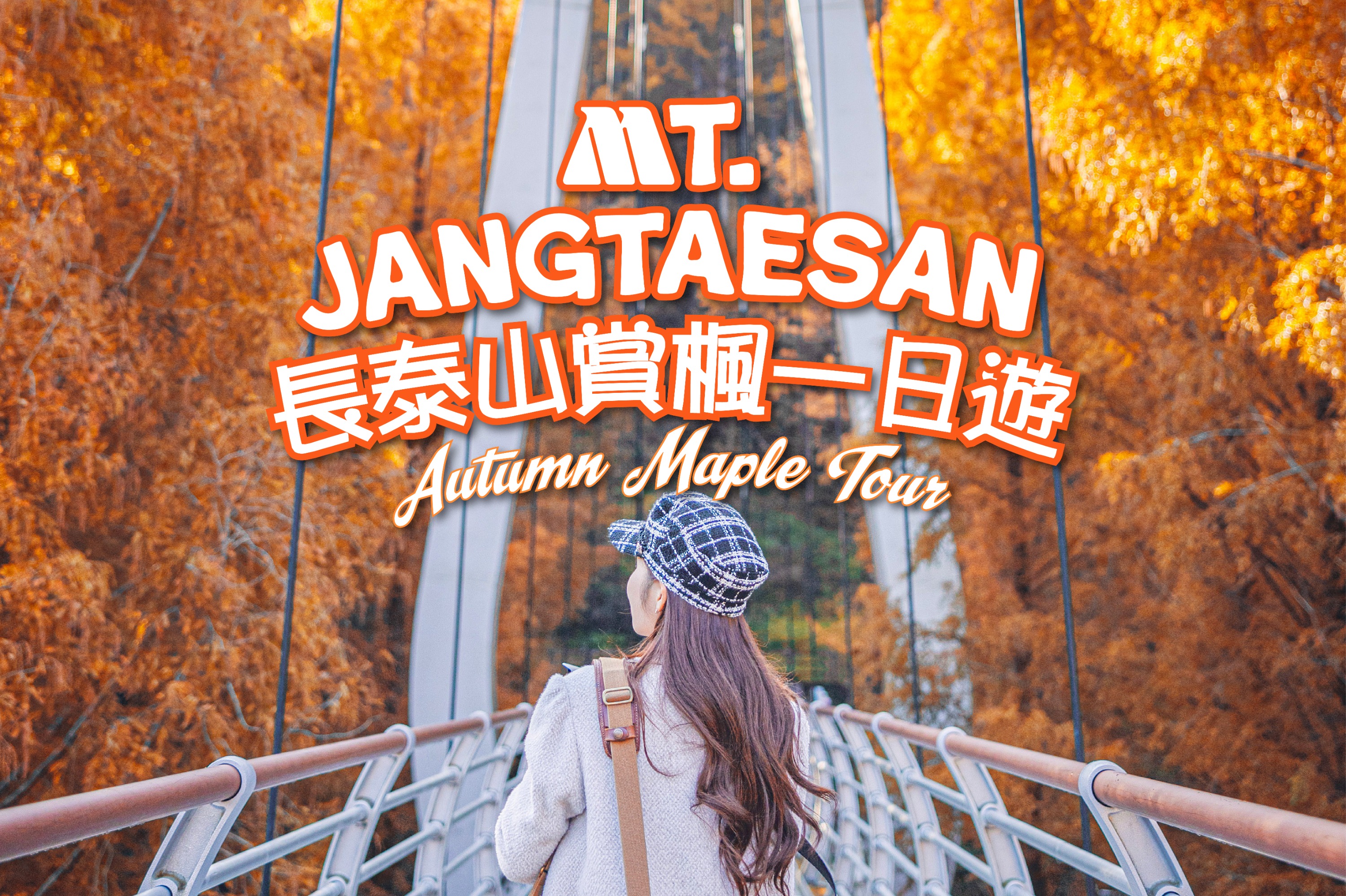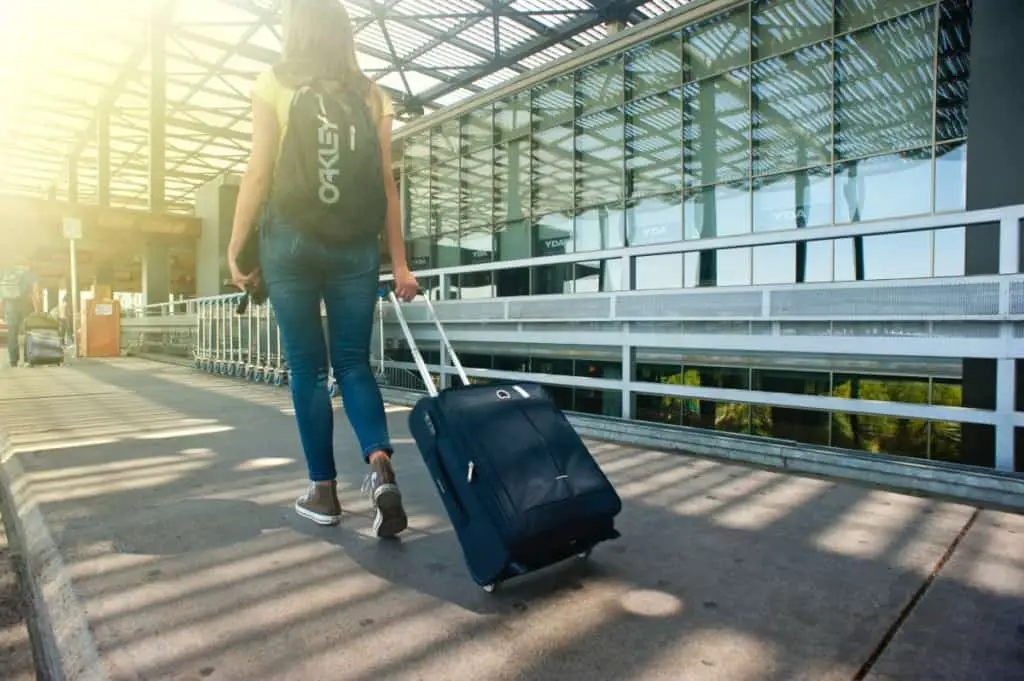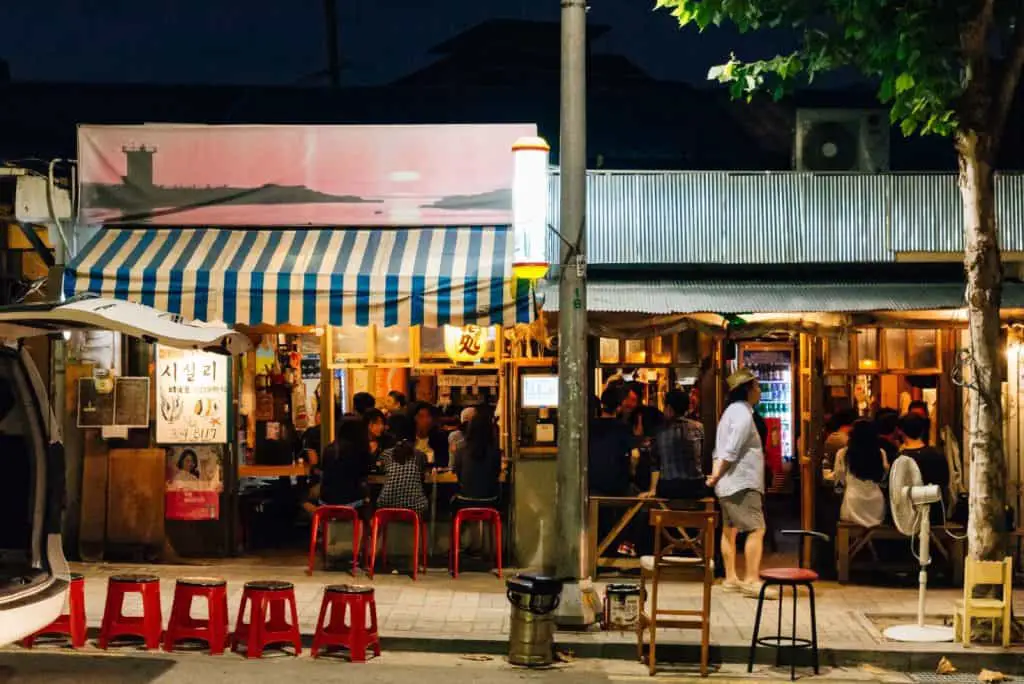📍 88, Changgyeonggung-ro, Jongno-gu, Seoul | 서울특별시 종로구 창경궁로 88
🚆 Subway Line 1 Jongno 5-ga Station Exit 8 | Subway Line 2, Line 5 Euljiro 4-ga Station Exit 4 100m
🕒 Market Open: from 9:00 am to 6:00 pm (closed Sunday) | Vintage Shop Open: from 10:00 am to 7:00 pm (closed Sunday) | Food Alley 09:00 – 23:00 KST (Never closed)
🌐 www.kwangjangmarket.co.kr
☎️ 02-2267-0291
✍🏻 Cheonggyecheon stream is conveniently nearby! Enjoy a walk in the heart of Seoul after savoring some delicious food. 😉
When exploring a new destination, one of the quickest ways to immerse yourself in its culture and traditions is by visiting the local market. In Seoul, Gwangjang Market is a must-visit. As one of the oldest traditional markets in the city, it not only offers a diverse range of items but is also renowned as a foodie paradise, boasting a plethora of attractive traditional dishes. Let’s delve into what this vibrant market has to offer.
How to get to Gwangjang market
Address: 88, Changgyeonggung-ro, Jongno-gu, Seoul | 서울특별시 종로구 창경궁로 88
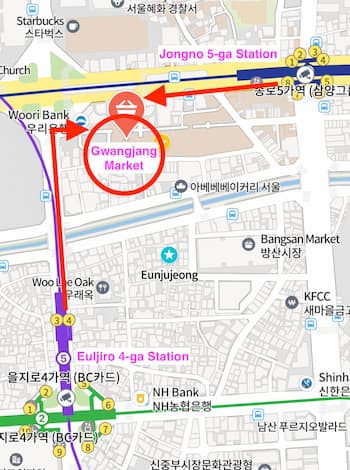
The best way to get to Gwangjang market is to catch a subway. Exit Jongno 5-ga Station from exit 8 and continue walking straight; you’ll find an entrance on your right. Alternatively, take exit 4 from Euljiro 4-ga Station, walk straight, and cross the Cheonggyecheon Stream. An entrance will appear on your right.
Tips
- Gwangjang Market is a treasure trove of Korean street food, from savory to sweet. Don’t hesitate to step outside your comfort zone and try something unfamiliar.
- Look for stalls with long lines or where locals are gathered. These are usually good indicators of quality and deliciousness.
- Ordering multiple small dishes to share with your group is a great way to try various flavors because the portion is rather big.
- Just plop yourself down when you see an open spot; don’t wait to be seated.
- Cash is still king in many Korean markets, including Gwangjang. While some vendors accept cards, having cash on hand is always a good idea to avoid inconveniences.
- Don’t forget the second floor! Explore the textile section, where you can find beautiful fabrics, traditional Korean clothing (hanbok), and other souvenirs.
- Learn a few basic Korean phrases: “Hello,” “Thank you,” and “How much?.” It can go a long way in showing respect and appreciation. Check out Ling, an e-learning tool for beginners to advanced speakers. Also, download Korea Tab, a great and simple way to incorporate learning Korean into your daily life.



About Gwangjang market
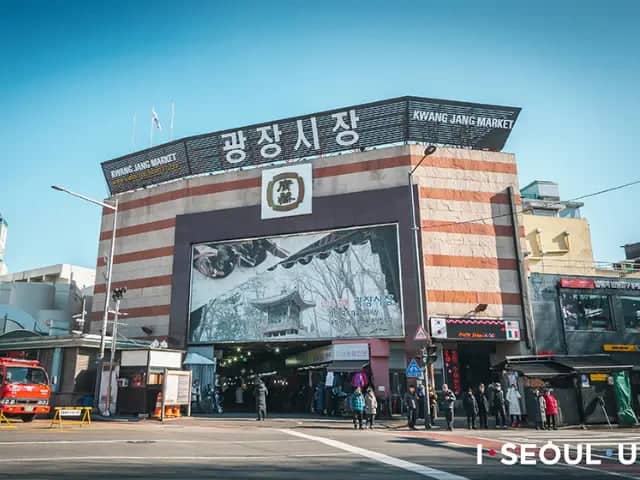
Established in 1905, Gwangjang Market or Kwangjang Market, the first permanent market in Korea, remains a thriving tourist hotspot today. The name Gwangjang signifies “to gather from afar and keep all together.” Originating as a modest trading center that sourced goods from nearby regions, it has evolved into a large wholesale market offering various products, including upholstery, imports, groceries, dried fish, traditional items, and more.
The market’s most renowned section is the food street, linked to East Gate, North Gate 2, and South Gate 1, attracting a diverse clientele with its extensive menu options. After being featured in Netflix’s “Asia Street Food” series, the market has become even more popular, attracting both locals and foreigners and becoming a must-visit spot for anyone in Seoul.
What to eat at Gwangjang Market
Hand-Cut Noodles (Kalguksu)
Kalguksu is a great dish for a chilly day. It’s a traditional Korean noodle dish that comes with hand-cut wheat flour noodles served hot in broth or cold with spicy sauce and toppings. The noodles have a unique texture because they’re cut with a big knife after rolling the dough. For an extra treat, you can try Mandukalguksu, which includes dumplings. A bowl of noodles usually costs about 6,000 KRW (4.5 USD).
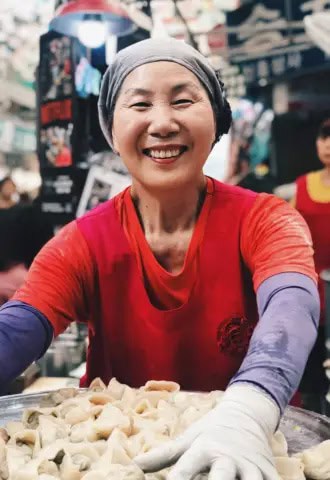
In Gwangjang Market, the best place to get it is at the stand of the Netflix lady in the center. You can spot her easily – she wears a pink apron, and her stand has a “Netflix” sign. She became well-known after featuring in episode 6 of Netflix’s “Asia Street Food.” It might be busy, but waiting for her tasty Kalguksu is worth it!
Bindaetteok (Mung Bean Pancakes)
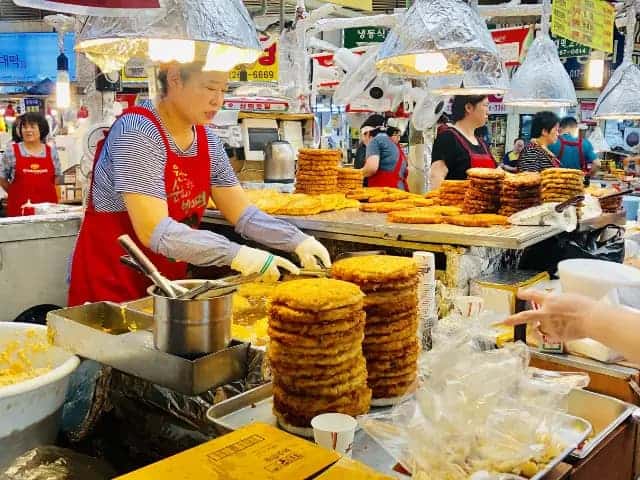
This dish is perhaps the most popular one at Gwangjang Market; you can notice a lot of stalls selling it. It’s a savory pancake from mixing ground mung beans, vegetables, and meat. The ingredients are mixed into a batter with various seasonings and then pan-fried on a griddle with oil. The pancake is crispy on the outside, soft on the inside, and served with a tasty soy sauce, vinegar, and pickled onion dip. The sauce has a slightly sweet, salty, and sour taste, making it a perfect complement to the pancakes. With around 5,000 KRW (3.7 USD), you can have a big and thick pancake.
Tteokbokki (Spicy Rice Cakes)
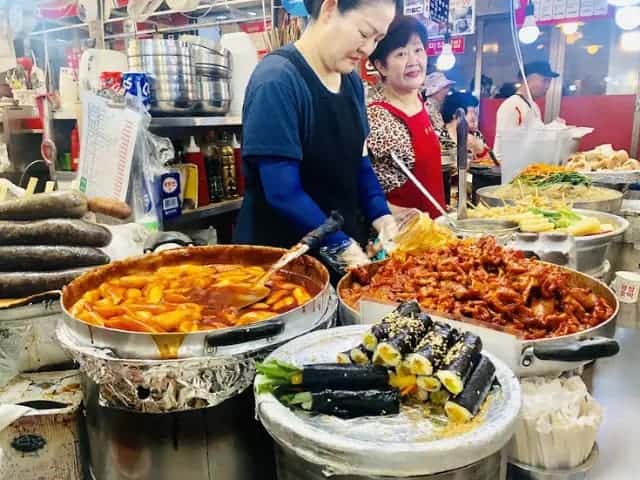
You can’t claim you’ve been to Korea without trying Tteokbokki. This widely enjoyed Korean street food features chewy rice cakes simmered in a sweet and spicy sauce alongside hard-boiled eggs, fishcakes, and other fried delights. While commonly served as an appetizer or snack, it’s also a hearty option for a main course. For a perfect combination, pair it with a kimbap or sundae. The cost of this flavorful treat typically hovers around 4,000 KRW (3 USD).
Mayak Kimbap
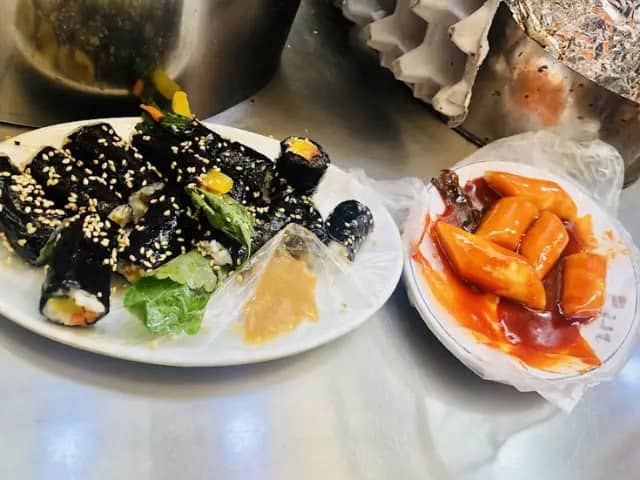
Mayak kimbap, unlike the larger standard version, is much smaller and bite-sized. It has four main ingredients: rice with sesame oil, carrots, pickled radish, and spinach, all wrapped up in toasted seaweed and sprinkled with sesame seeds. You can also find versions with pork or beef. Interestingly, the term “mayak” in Korean means “drugs,” not because it has anything illegal, but because it’s so addictive. It’s yummy and so small that you just can’t stop eating it.
Eomuk (Fishcakes)
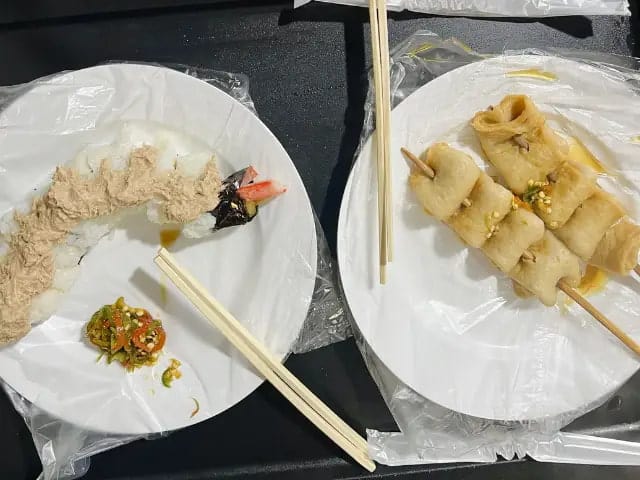
Eomuk is a Korean fishcake usually used in tteokbokki and kimbap. It’s also served on skewers as a street snack in anchovy broth. The broth is warm and comfortable, making it a perfect snack for a chilly night or cold winter day. Fishcakes have various types, some with veggies, while the Busan style is made mainly from fish paste and flour.
Korean Pancakes (Buchimgae)
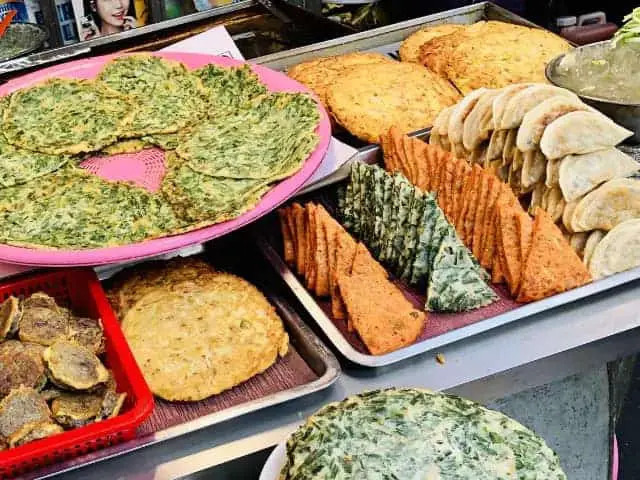
Buchimgae is a crispy Korean pancake popular in Gwangjang Market. Made with wheat flour, it’s pan-fried to a thin, flat fritter shape. Varieties like kimchi and chives add different flavors, and the pancake is served in pieces with a dipping sauce.
Cold buckwheat noodles (Naengmyeon)
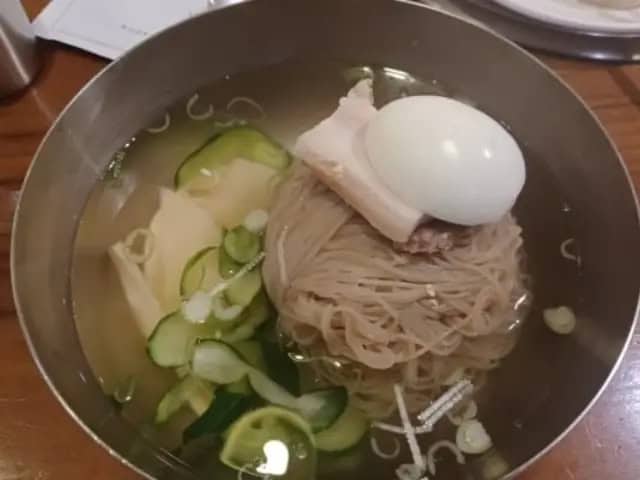
During hot summer days, naengmyeon is the ideal choice if you’re not in the mood for hot dishes. This Korean dish is a cold noodle broth soup with actual ice shavings. Topped with radish, cucumbers, and a hard-boiled egg, it also comes with vinegar and mustard sauce for added flavor.
There are usually two main types of cold noodles: mul-naengmyeon and bibim-naengmyeon. Mul-naengmyeon is soup based and not spicy while the bibim-naengmyeon has no soup but a red spicy sauce. Bibim means mix, so you mix the red spicy and sweet sauce with the buck wheat noodles .
Mandu (Dumplings)
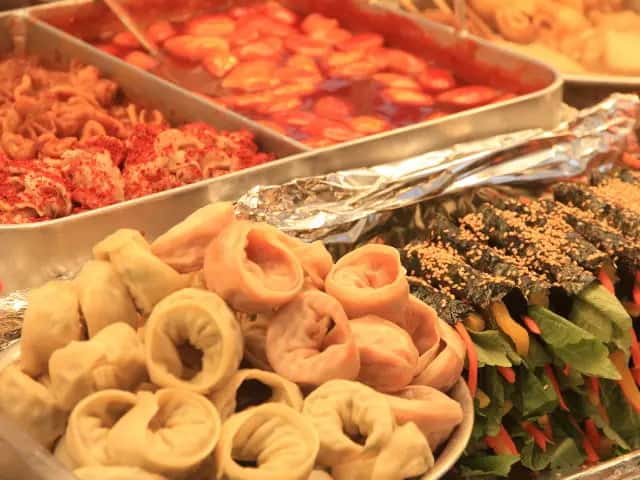
Gwangjang Market has many stalls selling Mandu or Korean dumplings. They’re made by wrapping ground meat, seafood, kimchi, or vegetables in a thin wheat flour layer. The filling is typically seasoned with sesame oil, garlic, ginger, and soy sauce. In Gwangjang Market, the most prevalent mandu versions are minced pork or kimchi-filled. Boiled or steamed, you can enjoy them solo with soy sauce or add them to noodles, ramyeon, or soup. Either way, they’re really tasty!
Sundae (Korean blood sausages)
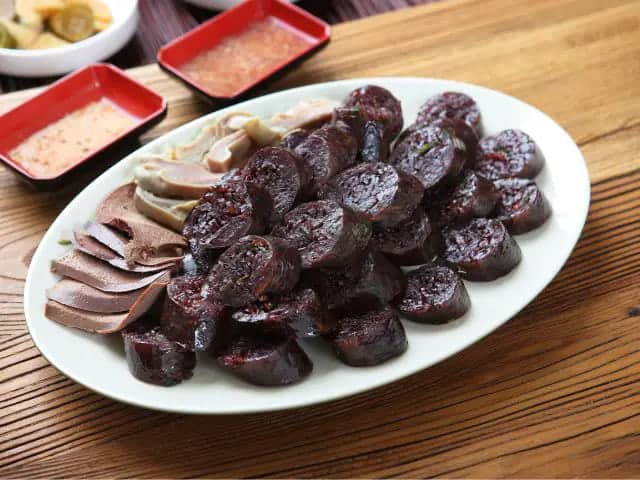
Another popular dish in Gwangjang Market is sundae or soondae. These sausages are packed with pig blood, glass noodles, or rice, resulting in a slightly chewy texture. Enjoy them with salt for a savory and delicious experience.
For the best sundae, head to the old lady at the middle of one of the alleyway. Although she doesn’t have a dedicated stall, you can spot her on a small wooden chair, expertly chopping up blood sausage. Despite lacking a formal setup, there’s always a bustling line of eager customers.
Bibimbap (Mixed Rice)
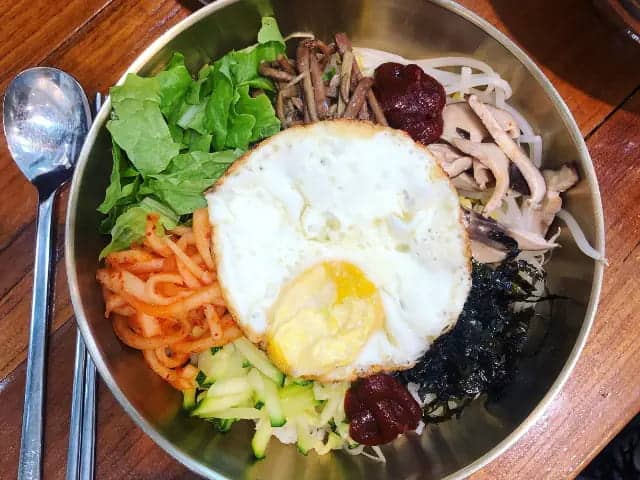
In some stalls at Gwangjang Market, you’ll find bowls of fresh veggies. That’s where you can try bibimbap—a dish with steamed rice topped with carrots, spinach, bean sprouts, and mushrooms. It’s served with a fried egg and spicy chili pepper sauce. Despite its neat look, the trick is to mix everything before eating. At Gwangjang Market, they often use rice with barley and other grains, making it more nutritious.
Steak tartare (Yuk-hoe)
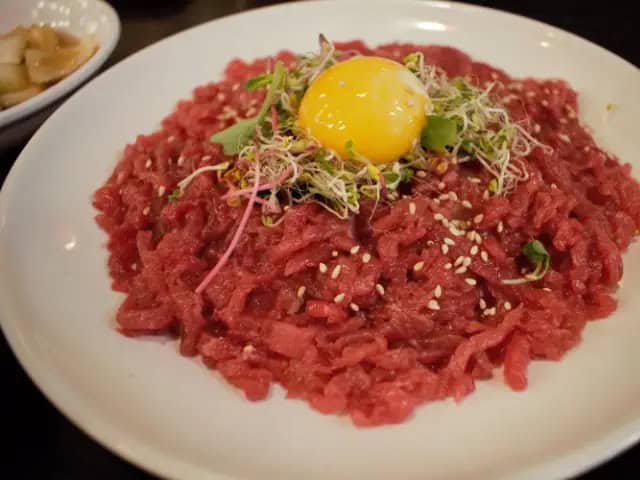
Yuk-hoe is a popular dish at Gwangjang Market. It consists of thinly sliced beef marinated with soy sauce, garlic, sugar, sesame oil, salt, and pepper. Served with a raw egg and sliced Korean pear. Although it’s raw meat, it’s not hard to eat and if you can eat sushi you can handle this one.
Walnut Cakes (Hodu gwaja)
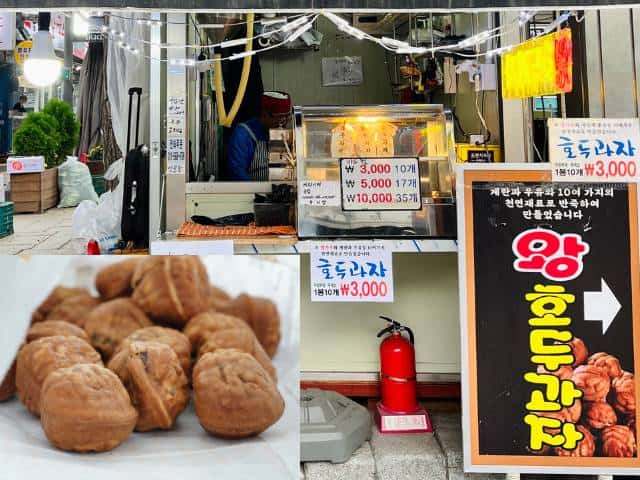
If you have a sweet tooth, head to a stall selling hodo kwaja. Hodo kwaja, or walnut cookie, is a sweet cake batter mixed with chunks of walnut, baked in a special pan that gives the little cakes the appearance of real walnuts. The cakes are then filled with either red or mung bean paste or custard. Don’t just settle for one. You’ll want more! Grab at least six and enjoy them as you walk.
Hotteok
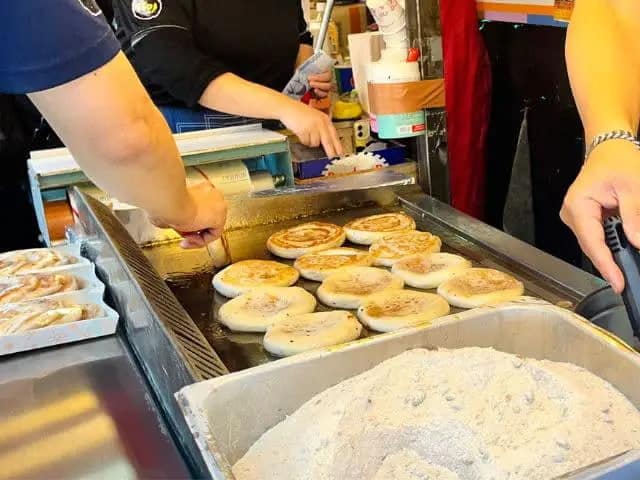
Cap off your food tour with a delightful hotteok dessert – one of the most delicious treats in the market. This sweet and sticky Korean dessert pancake is usually stuffed with delightful fillings like red beans, nuts, cheese, or honey. Prices start at 1,500 KRW (1.1 USD).
What to buy in Gwangjang market
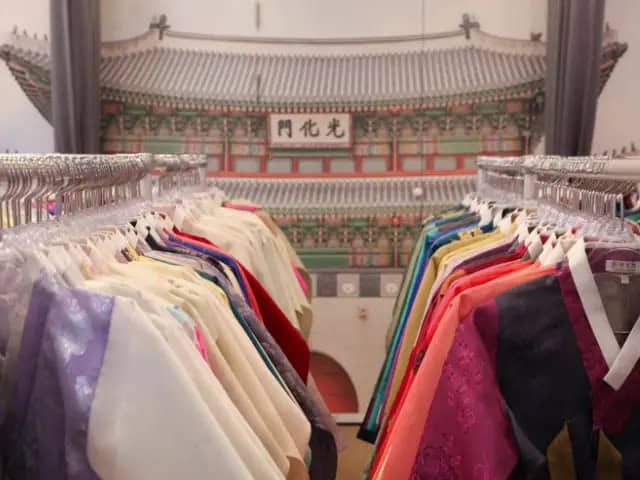
While Gwangjang Market is famous for its delectable food, it’s also a great destination for finding gifts. You can shop for Korean-style snacks like dried mangos and strawberries or explore snacks made from fresh seafood such as kim and fish.
The market’s second floor is renowned for selling the largest selection of silk, satin, and linen bed sheets in Seoul. There are also a lot of vintage fashion shops that offer great vintage items, so if you’re looking for vintage clothes, that is a big reason to explore this market. Additionally, it offers a wide variety of hanbok (traditional Korean attire) at very reasonable prices, making it a great idea for a gift or a personal memento.
Best time to visit Gwangjang market
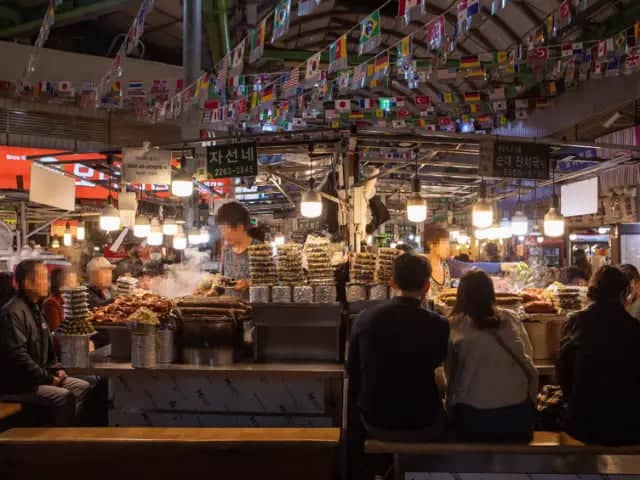
To avoid crowds at Gwangjang Market, visiting in the early morning or late afternoon/evening on weekdays is advisable. The peak hours, typically crowded, are during lunchtime (noon to 3 pm) and on weekends when locals flock to the market. While weekends are bustling, they offer the best opportunity to experience the market’s vibrant energy.
The winter season is ideal for a Gwangjang Market visit when Seoul is exceptionally cold. There’s a special comfort in enjoying hot dishes like mandu-kalguksu, spicy tteokbokki, or crispy fried bindae-tteok in freezing temperatures.
What to do near Gwangjang market
Cheonggyecheon Stream
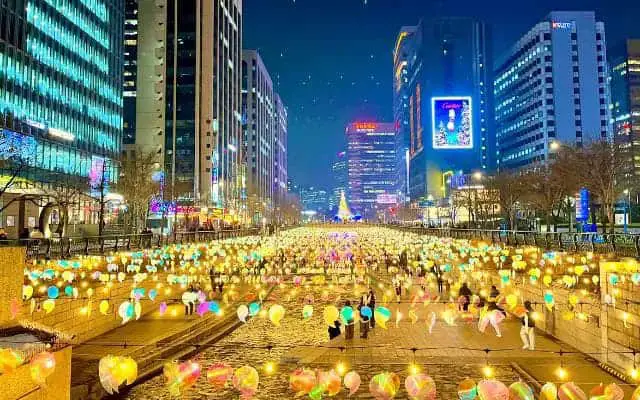
- Address: 1 Taepyeongno 1-ga, Jung-gu, Seoul
Cheonggyecheon Stream in Seoul showcases impressive urban revitalization. Once a neglected waterway, this 11-kilometer green oasis is now a vibrant blend of nature and culture in the heart of the city. Strolling along, you’ll be captivated by the harmonious integration of art installations and nature, providing a serene escape from urban life. As night falls, enchanting lights transform the stream, adding a magical touch to the cityscape. Don’t miss the annual Light Festival in winter, turning the stream into a dazzling wonderland of lights and colors. A must-visit in December!
Insadong street
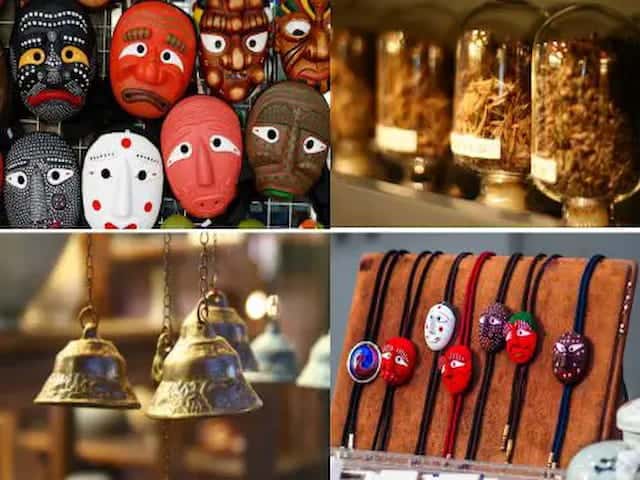
- Address: Insa-dong, Jongno-gu, Seoul
Insadong is a neighborhood that preserves the original Korean Hanok architecture, providing an immersive experience in Korean culture. Known for its intriguing and captivating charms, the area is most renowned for its traditional architecture, art exhibitions, and a plethora of charming cafés, tea shops, and restaurants featuring beautiful concepts and décor. It’s an ideal place to relax with friends, enjoy a coffee, and explore various art exhibitions.

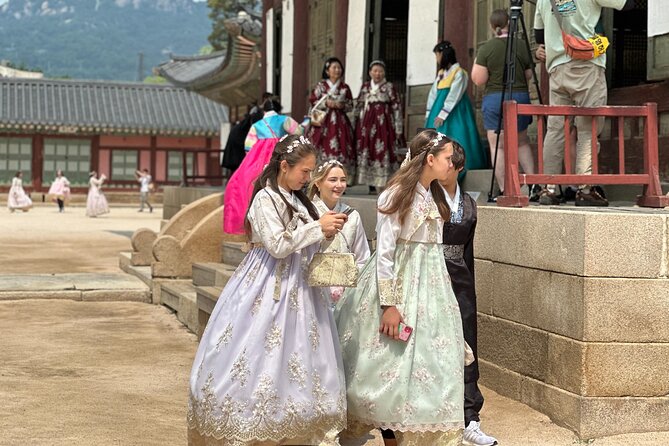

Dongdaemun Design Plaza (DDP)
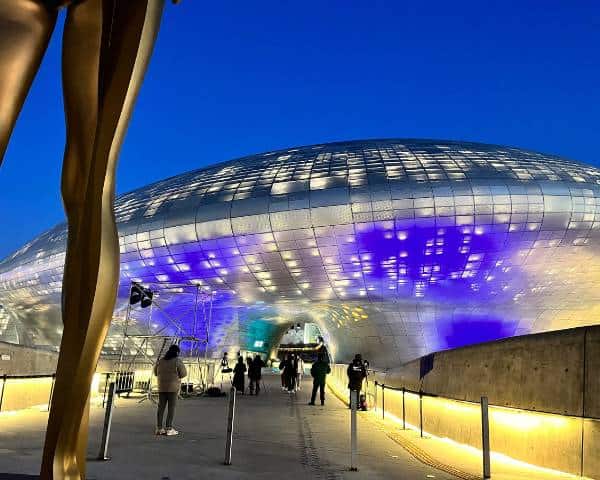
- Address: 281, Eulji-ro, Jung-gu, Seoul
For enthusiasts of modern architecture and Korean design culture, the Dongdaemun Design Plaza is the perfect destination. Designed by the renowned architect Zaha Hadid, the building’s exterior features delicate curves and bold shapes, making it a favorite among photographers.
The plaza is a hub for both domestic and international activities, hosting a myriad of events, including exhibitions, fashion shows, forums, and conferences. Inside, you’ll find art halls, museums, design laboratories, and Oullim Square, along with the Dongdaemun History & Culture Park and a variety of intriguing retail stalls.



In conclusion, Gwangjang Market is a microcosm of Seoul’s soul, a place where the past and present coexist in a vibrant tapestry. Whether you are a foodie, a culture enthusiast, or a savvy shopper, Gwangjang Market promises an unforgettable experience. Hence, whether you happen to be in Seoul or are simply considering a vacation there, don’t forget to check out this famous market—you won’t be disappointed!
You may also like:
- Gyeongbokgung Palace 경복궁: All you need to know
- Ultimate Guide to Namdaemun Market
- Must-try Korean Street Foods in Namdaemun Market
IVK’s Top Picks – Day Tours, Tickets, and Travel Activities
Seasonal Picks!😍


